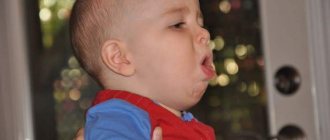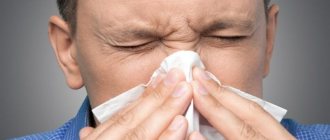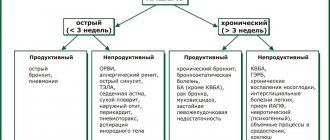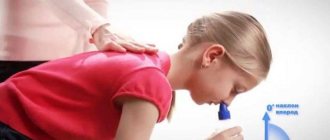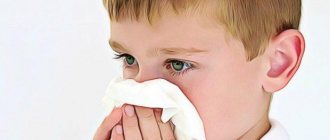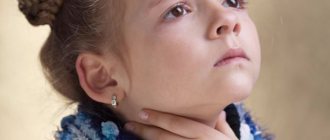Causes of a child's cough without fever
Any cough is a reflex to the appearance of obstacles in the respiratory canals. In this way, the body tries to get rid of anything foreign that makes breathing difficult. Cough syndrome is not an independent disease, but can be one of the symptoms of a pathology. However, it cannot be considered a sign of illness either. Often the reflex occurs for physiological reasons not related to pathologies.
Based on the nature of its manifestation, cough can be divided into dry and wet (wet). The first type belongs to the unproductive category, because the air flow does not remove phlegm. The second is called productive and occurs with the release of sputum, which takes with it all the interference. In terms of duration, the cough reflex can be short-term, acute and protracted, chronic. The acute variety lasts no more than 10-15 days, but may be accompanied by a severe course. The chronic type lasts more than 20 days, may subside, but then return again. Periods of exacerbation alternate with remission.
The causes of cough in a child without various types of fever can be divided into 2 categories, physiological and pathogenic.
Physiological, non-pathogenic causes:
- Entry of foreign bodies into the upper respiratory tract. This reason is most typical for very young children, when breathing may be difficult due to food crumbs, small parts of toys, wool or fluff, etc.
- Dry indoors. Insufficient humidity in the room where the child is located can cause the mucous membrane to dry out, resulting in a reflex.
- Chemical irritation. Various volatile components of household chemicals and poor ecology can irritate the mucous membrane, provoking an attack.
Pathogenic factors:
- The initial stage of acute respiratory infections.
- Chronic diseases such as bronchitis, tracheitis, pharyngitis.
- Infection in the ENT organs, penetrating the respiratory canals during sinusitis, tonsillitis and other foci of infection.
- Tuberculosis.
- Helminthiasis, helminthic infestations,
- Gastrointestinal diseases accompanied by reflux of gastric contents and biliary dyskinesia.
A cough without body hyperthermia may be a consequence of whooping cough.
Quite often, the cough reflex is associated with an allergic reaction of the body. It is found to be associated with heart diseases (cardiopathologies). The neurological influence should not be discounted. Stress, nervous overload, and neuroses can provoke a cough without hyperthermia.
How to help your child with a cough
Help from parents to a child with a cough consists, first of all, of maximum care and care - he should feel safe and secure in the family. Of course, consultation with a pediatrician is necessary, who will help develop an action plan at all stages of treatment and prevent any negative consequences.
The doctor prescribes the treatment, and the parents’ task is to ensure its clear and consistent implementation. To relieve a child’s cough, Stodal syrup is often recommended, which has antimicrobial, antitussive and anti-inflammatory effects1. It helps relieve coughs and has no age restrictions2.
Stodal is especially effective at the initial stage of ARVI treatment. Taking Stodal syrup from the first days of the disease can reduce the treatment of cough due to ARVI to 1 week3.
- French press for tea and coffee - how to choose and use
- Antibiotic Flemoxin Solutab
- Stuffed zucchini in the oven
For a wet cough, you need products with a mucolytic and expectorant effect, preferably plant-based. In addition, bronchodilators are indicated, which reduce bronchospasm and facilitate sputum production.
The use of any medications should be accompanied by plenty of warm drinks. It is optimal to give warm milk with honey, compotes, juices to drink, but not black tea, which tends to worsen the cough.
When coughing, do not gargle with soda solution - soda dries out the mucous membrane, which leads to increased irritation.
In the room where the child is located, it is necessary to ensure a comfortable temperature, a constant flow of fresh air and humidity at 70%. Walking in the fresh air is also important, but without active games. A clear daily routine, timely intake of medications, food and proper sleep are important.
Dry cough in a child without fever
A dry cough in a child without fever can be pathogenic or non-pathogenic. With physiological or allergic etiology, it can manifest itself acutely, but for a short time. Most often, it goes away on its own without special treatment after the cessation of exposure to the external stimulus.
A cough caused by an infection is more dangerous. For children, bronchitis, pharyngitis and laryngitis are most common. The cough may be accompanied by a runny nose and general weakness, as well as headaches. The nature of the manifestation can be paroxysmal or constant with intensification at night. The absence of sputum leads to progression of cough intensity.
Another common cause of dry cough is helminthic activity. The waste products of worms cause intoxication of the body and allergic reactions, which causes a cough reflex.
Proper treatment of wet cough in children
The following folk recipes will help you cope with a wet cough:
- Cabbage drink
. You need to squeeze the leaves of fresh cabbage so that you get half a glass of juice. Stir with 0.5 tsp. honey or sugar and heat. Give the child 1⁄4 cup, 4 times a day. - Blackcurrant juice
. The berries (3 tbsp) are ground with sugar (2 tsp) and poured with a glass of warm water. Mix well and give to the baby to drink. Take half a glass 2 times a day. - Fig porridge
. You need to take dried or fresh figs (50 g) and chop them in any way. Mix with 0.5 tsp. liquid honey and 3 tbsp. warm milk. Give the child 2 tsp. no more than 4 times a day.
In addition to the recipes listed, you can use cabbage leaves smeared with honey. It is applied to the baby’s back, in the area between the shoulder blades (for 15 minutes). You also need to remember that treatment of wet cough in children using traditional methods should be carried out only after consultation with a doctor.
Wet cough in a child without fever
It usually indicates the presence of pathology. It can be a symptom of the following disorders: damage to the bronchi and trachea, acute respiratory infections and colds, bronchial asthma, pneumonia, tuberculosis. It can be provoked by cardiac pathology. A coughing attack usually brings temporary relief, because... phlegm clears the channels and breathing becomes easier. However, after some time, the airways become clogged again, and the coughing attack repeats. Strengthening is noted in the morning, which is explained by the accumulation of mucus during sleep.
The duration of a wet cough can be significant. It may take 2-3 weeks for the bronchi to completely clear. During this period, we must remember that the secreted sputum is saturated with pathogenic microorganisms, which is dangerous for others. The dangerous progression of the underlying disease is indicated by the appearance of additional symptoms such as rhinitis, sneezing, general weakness and malaise, chills, heavy breathing and shortness of breath, redness of the facial skin.
The type of sputum produced can also indicate the nature of the pathology. Bronchitis produces colorless mucus. The appearance of an orange tint may indicate the development of pneumonia. A thick, dense mass is characteristic of bronchial asthma. Blood impurities indicate tuberculosis or serious cardiac problems.
Purulent impurities are very dangerous, which may indicate a pulmonary abscess.
How to treat a hoarse cough in a child if it is caused by bronchitis
If a child has had pneumonia or any other infectious lung disease, he or she may develop bronchitis if not treated properly. This disease is a constant, sluggish inflammation of the lungs, which does not lead to a significant increase in temperature, but tends to worsen at any opportunity.
It is distinguished from other possible causes of a hoarse cough by its severe symptoms:
- Hoarse cough. It occurs as a response to constant irritation of the lungs and an attempt to get rid of pathogenic microorganisms and traces of their vital activity.
- Dyspnea. It occurs as a response to any physical activity.
- Sputum. It is usually colorless and odorless, but the further the disease progresses, the more likely it is to become yellowish or greenish in color due to pus.
- Wheezing. Sputum during bronchitis is sticky, difficult to remove and easily clogs the bronchi. As a result, breathing is difficult and accompanied by constant wheezing.
Bronchitis also cannot be treated at home, especially when it comes to a child. You should definitely consult a doctor who will prescribe treatment:
- antibiotics – kill the causative agent of the disease;
- expectorants - make sputum more liquid, which allows it to pass away much easier and helps cleanse the lungs;
- anti-inflammatory - relieve swelling, relax the smooth muscles of the lungs and increase the clearance in the bronchi, which leads to easier breathing.
Also, with a hoarse cough without fever, which is caused by bronchitis, the child is prescribed inhalations with all of the above remedies - this helps him breathe easier and at the same time moisturizes the throat. Increasing immunity also becomes an important part of the therapy - parents are advised to walk with the child more often, monitor his diet and make sure that he sleeps as much as he needs.
If left untreated, bronchitis can evolve into chronic obstructive pulmonary disease, which is characterized by constant oxygen deprivation and shortness of breath, which first occurs only during physical activity, but then at rest.
Barking cough in a child without fever
It especially annoys the baby, occurring in the form of a severe attack. Wheezing and whistling sounds appear in the chest area, and the voice timbre changes. A characteristic sign is sounds reminiscent of a dog barking. The most common causes: bronchial asthma, false croup, whooping cough, laryngitis, diphtheria, laryngeal cyst, acute allergic reaction. An attack can also be caused by non-pathogenic factors - excessively dry indoor air, ingestion of a foreign body.
In addition to cough, other symptoms are often observed. The most characteristic are: general weakness, chills, heavy breathing and shortness of breath, headache, pain in the chest and throat. Infants develop swelling of the mucous membrane, cyanosis on the lips and upper extremities.
This type of cough indicates a dangerous development of pathologies and requires urgent medical attention.
Why does a child cough?
Coughing in a child can be caused by a variety of reasons. Most of them are easily eliminated with a little effort on the part of parents.
Upper respiratory tract diseases and acute respiratory viral infections
If the baby begins to cough periodically, this may be nothing more than the most “banal” cold. Do not put off visiting a doctor if coughing attacks are accompanied by:
- increased temperature;
- redness of the throat;
- the occurrence of wheezing;
- lethargy, drowsiness, increased irritability of the baby;
- runny nose, lacrimation.
All of these symptoms indicate a cold. It is not recommended to treat it yourself, as this can lead to complications .
Children must be given medications according to their age. Tablets for adults contain a higher concentration of the active substance, so they can lead to an overdose.
Dusty, gassy, smoky indoor air
Every parent knows how important it is to maintain ventilation in the baby’s room. But, unfortunately, not every parent follows this. As a result, lack of oxygen causes the baby to cough and sneeze. At the same time, the child complains that his throat seems to be sore. But these symptoms disappear immediately after basic cleaning and airing of the children's room.
Allergy
An allergic reaction in a child is not always accompanied by external symptoms (skin rash, redness, itching, small sores). In some cases, the only manifestation of an allergy in a baby is a cough. It goes away immediately after all provoking foods disappear from the child’s diet, if the symptom is caused by a food allergy.
Dust, pet hair, and plant pollen can also act as an irritant. It is important to detect the allergen in time and stop its effect on the body.
Some diseases
If a child coughs all the time, this may indicate various diseases:
- Bronchial asthma. Accompanied by a dry cough, which worsens when lying down. It is observed mainly at night.
- Diseases of the gastrointestinal tract. Acid from the stomach rushes into the esophagus, irritating the neck. It manifests itself as constant itching and dry cough.
- Heart defects and chronic diseases of the cardiovascular system. The baby may be pale and periodically lose consciousness. The heart is slightly enlarged and puts pressure on the lungs, causing a cough.
Only a pediatrician can identify or exclude these diseases. Therefore, there is no need to try to make a diagnosis yourself, but after the first signs appear, consult a specialist.
Penetration of a foreign object into a child's respiratory system
Often, coughing in children is caused by a foreign object entering the respiratory tract (toys, pieces of paper, etc.). You should not wait for the trouble to go away on its own; the most correct option is to urgently go to the hospital.
The foreign body will move from the trachea into the lungs, injuring children's organs. This condition is very dangerous. The baby may suffocate.
Severe cough in a child without fever
Lack of treatment leads to the development of the disease. The result is a persistent, severe cough. It may indicate a serious complication such as pneumothorax. A severe, dry cough may indicate respiratory or heart failure. In this case, circulatory problems may occur. Oxygen supply to the cells of internal organs deteriorates, which is manifested in loss of appetite and sleep. Frequent irritation of the brain centers leads to vomiting.
A severe cough is dangerous due to the following complications: suffocation, Quincke's edema, bronchial spasms, pulmonary and respiratory failure, internal bleeding, anaphylactic shock.
Folk recipes
If the baby does not have a fever, some traditional medicine will be effective. Let's give a couple of examples.
- To soften a cough, you can use warm milk mixed with mineral water in a 1:1 ratio. An alternative version of this drug is to mix heated milk with a teaspoon of natural honey and add a small slice of fresh butter. This remedy will soften the irritated throat, and for some time the cough will stop bothering the child.
- A good remedy is radish juice. It should be given to the baby a teaspoon every three hours. How to get this juice? You can divide the radish in half, pour a little honey on each half and sprinkle a little granulated sugar. Then place it in a deep plate so that the radish lies at an angle. Literally after an hour, the healing juice can be drained and used for its intended purpose. Remember that it should not be given to children under one year of age.
